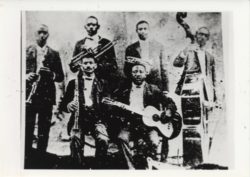Buddy Bolden
Cornetist Buddy Bolden was the first documented player of New Orleans jazz.

Louisiana State Museum
The Buddy Bolden Band.
Charles “Buddy” Bolden, the first documented practitioner of the music now known as New Orleans jazz, has evolved into a mythic figure. Fans claimed that they could hear his cornet playing for miles around town, especially when Bolden summoned them by “calling [his] children home.” Bolden inspired Jelly Roll Morton’s “I Thought I Heard Buddy Bolden Say” (a.k.a. “Buddy Bolden Blues”) and Sidney Bechet’s “Buddy Bolden Stomp.” Historic novels such as Michael Ondaatje’s Coming Through Slaughter and David Fulmer’s Chasing the Devil’s Tail feature characters modeled on Bolden, and in 2019 Abramorama released Bolden, a feature length film based on the musician’s life.
No interviews with Bolden, who performed from 1895 to 1906, were ever published; the few recordings he allegedly made have disappeared, if indeed they ever existed. The most significant archival item is a photo of Bolden and his band from 1905. The instrumentation in this photo, besides Bolden on cornet, included a trombone, two clarinets, an acoustic guitar, and an upright bass. Even the photo has generated some controversy, with critics claiming that it was printed backwards.
It was not until the 1930s, when jazz emerged as a topic worthy of serious attention, that researchers began to examine Bolden’s life and career. Though Bolden had died, his name remained prominent via oral history. The pioneering jazz scholars who sought to research Bolden’s story did so primarily by interviewing his surviving band members and associates. For various reasons, including the vagaries of memory and self-serving agendas, their information was not always accurate. Errors and all, however, such data were widely disseminated and came to be accepted as fact. It was not until the 1970s that Donald M. Marquis, then the jazz curator of the Louisiana State Museum, undertook a definitive, in-depth study of Bolden.
The son of Westmore Bolden and Alice Harris, Charles Bolden grew up in various parts of the present-day Central City and Irish Channel neighborhoods of New Orleans. Much of his early music training came courtesy of a neighbor named Manuel Hall, who taught Bolden the rudiments of the cornet. Spirituals, jubilee singing, and the exuberant “shouts” of his Baptist background also shaped Bolden’s musical style. The brass bands that played at functions, secular and religious, for churches, fraternal lodges, and social aid and pleasure clubs also proved influential. These bands performed a combination of ragtime and military music that, in its blend of African and European concepts, presaged the hybrid that soon became jazz.
Although not well-documented, Bolden seems to have been further influenced by various African American and Afro Caribbean folk traditions of the day. Blues, though not always referred to as such, then, emerged during Bolden’s childhood. “Jug-band” performances, often on ad hoc, utilitarian instruments like washtubs and washboards, anticipated jazz traditions of improvisation and the use of stop-time. Pre–Civil War practices such as field hollers and work songs were still thriving throughout the South, including New Orleans, where a tradition of singing street vendors flourished for generations.
In addition, Bolden’s music likely bore the imprint of the African-retentive chants and Afro Cuban drumming that thrived in the New Orleans area during slavery, most notably at weekly gatherings at Congo Square. This tradition lingered palpably in the city’s Black community, especially in terms of rhythm and improvisation; in some ways, it remains a significant factor yet today. Reflecting the cultural diversity that has always characterized New Orleans, Bolden would have also heard Black musicians playing more staid European forms such as the waltz, quadrille, schottische, and mazurka.
Bolden’s band coalesced around 1895, initially led by guitarist Charles Galloway. But Bolden soon came to run the band, in keeping with his reportedly outgoing personality and the loud, aggressive playing style that many observers noted. At first Bolden kept his day job as a laborer, but the popularity of his band gradually allowed him to play full-time. By 1902, the New Orleans city directory listed him as a musician. As his popularity increased, he acquired the nickname “Kid,” which designated an up-and-comer, followed by “King,” signifying that he had reached the top rung of his profession. Bolden maintained a full schedule, playing many more dances than parades, performing all over town, but concentrating on the cluster of clubs and taverns in the vicinity of South Rampart and Perdido Streets, an area known as Back-of-Town.
Bolden’s contemporaries and sidemen included celebrated early New Orleans jazz musicians such as clarinetists Alphonse Picou, George Baquet, and a young Sidney Bechet; cornetist/alto saxophonist Isidore Barbarin; bassist Alcide “Slow Drag” Pavageau; multi-instrumentalist Peter Bocage; and drummer Louis Cottrell. As a featured soloist, Bolden’s main competitor was the violinist who headlined John Robichaux’s Dance Orchestra.
By 1906, the pressures of success and the ill effects of alcoholism led Bolden to a number of psychotic episodes that included an assault on his mother. After several arrests, he was declared insane and, in the spring of 1907, committed to a state mental hospital in Jackson, Louisiana. His condition, then diagnosed as dementia praecox, is now known as schizophrenia. These circumstances spawned the bizarre theory, proposed in 2001 by Dr. Sean Spence of the University of Sheffield, UK, that Bolden’s musical talent was symptomatic of his mental illness. By extension, Spence implied, jazz is a psychiatric condition.
Bolden stayed in the facility at Jackson until his death in 1931. He was buried in an unmarked grave in New Orleans’s Holt Cemetery. Ninety years after Bolden’s mental breakdown, a monument was erected in his honor at Holt Cemetery, following a second line jazz funeral. Today, little has been added to Don Marquis’s research, but Buddy Bolden’s contributions to New Orleans jazz have received recognition at last.
